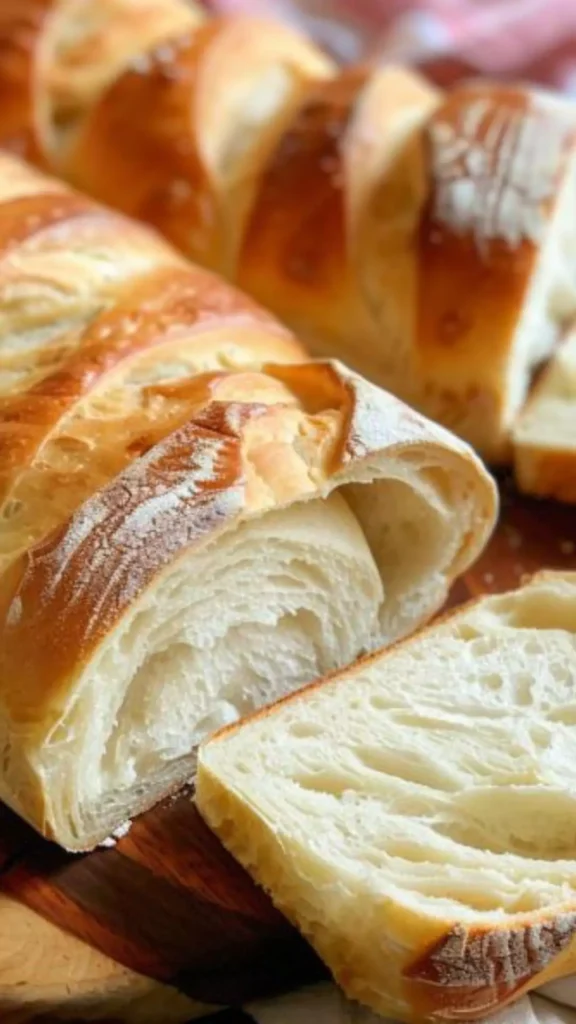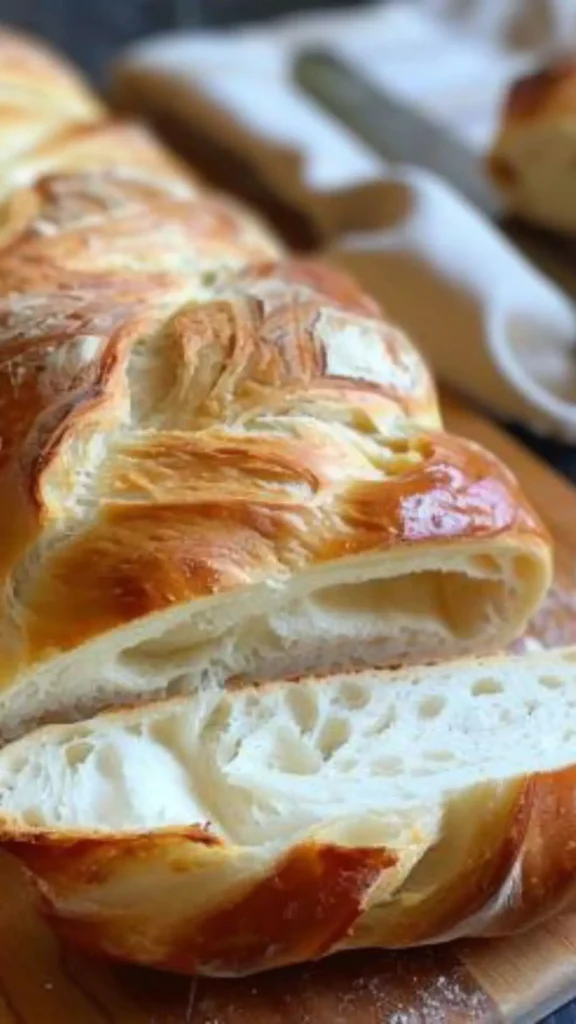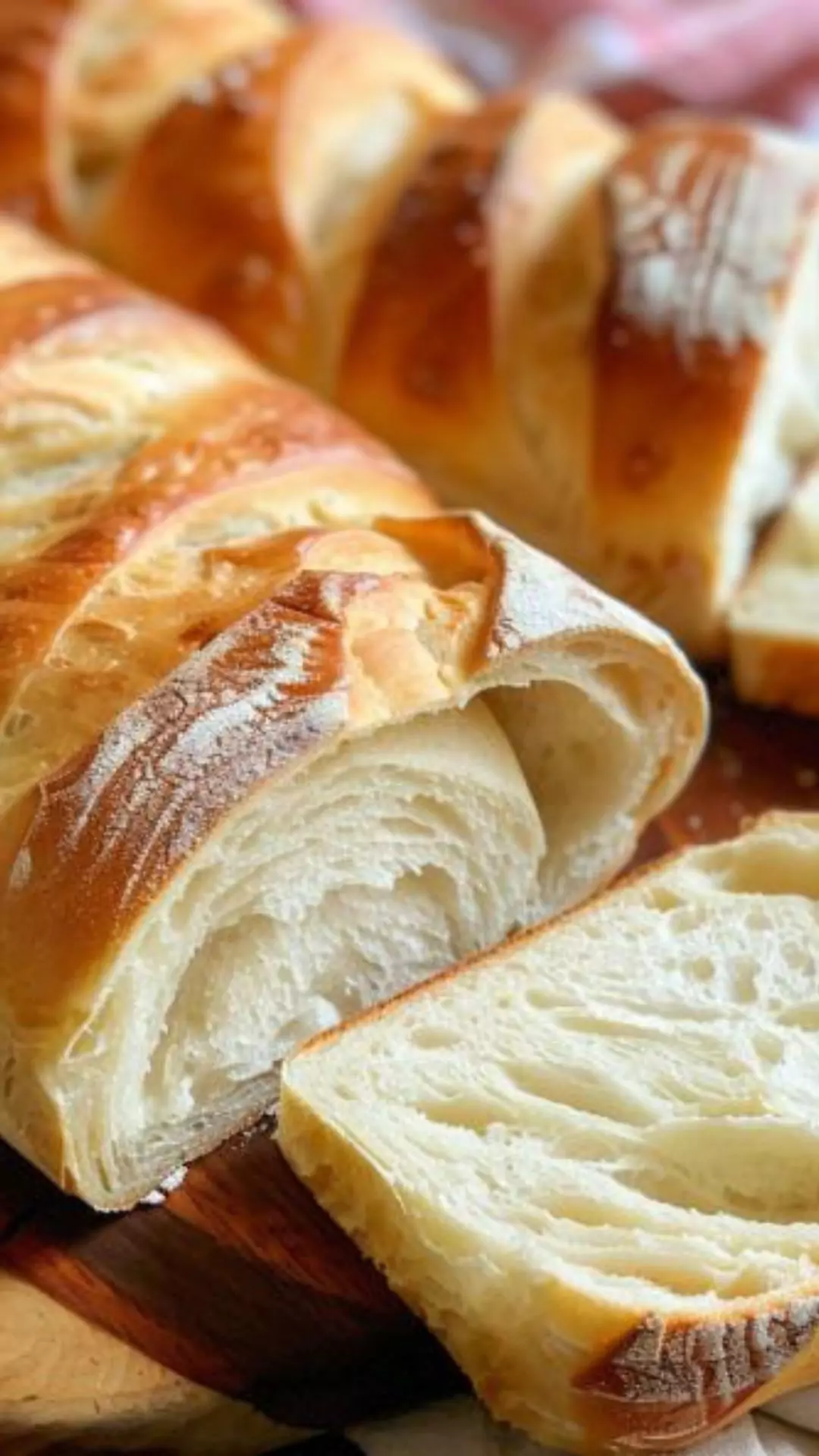There’s a certain allure to biting into soft, fluffy French bread straight out of the oven. It’s hearty yet tender, rich yet subtle. Oh, the things you can pair it with!
I love dipping it in homemade Raisin Sauce. It’s a match made in heaven. You’ll find it perfect with soups like Phillips Crab Soup or Marcella Hazan Lentil.
Another amazing pairing is with Rye Bread Pickle with all sorts of cheeses and cured meats. For a sweet twist, spread some strawberry or apricot preserves on a slice. The possibilities are endless, and each will only enhance the experience.
Today, I will take you on a bread-baking adventure that will add a delightful element to your meal. This isn’t just any bread; it’s a soft, fluffy French bread recipe that will make your taste buds dance.

But before we knead into that, a bit about myself – I’m a registered dietitian and a passionate food blogger. My love for cooking revolves around easy, nutritious, and incredibly delicious recipes. Now, let’s dive into what’s going to make your kitchen smell divine.
Soft fluffy French bread is unlike the traditional crusty baguette you might visualize. Instead, it’s supple, airy, and has a golden exterior. It’s the bread that hugs your senses, offering a delicate balance between texture and flavor. Made with just a few simple ingredients, this bread rises to the occasion, literally and figuratively.
What Does It Taste Like?
Imagine biting into a cloud. This bread is the epitome of softness, with a slight sweetness, and a gentle flavor imparted by olive oil. It’s versatile, making it perfect to complement a variety of dishes. The crumb is beautifully tender, while the crust provides that subtle crunch without being overly hard. It’s like a warm hug for your taste buds.
You will also like the following Side Dish recipes!
Why This Recipe Works
Simple Ingredients
This recipe uses basic pantry staples that you likely already have. Flour, water, yeast, oil, sugar, and salt – that’s it! There’s nothing fancy here, just straightforward ingredients coming together to create magic.
Ease of Preparation
No complicated steps here. The process is straightforward and doesn’t require any advanced baking skills. Even beginners can tackle this recipe with confidence, making it a great way to start your baking journey.
Versatility
This bread can accompany almost anything, from soups to salads and everything in between. Its mild flavor means it pairs well with both sweet and savory dishes, adding a comforting element to any meal.
Healthier Option
Compared to store-bought bread which can be full of preservatives and additives, this homemade version is a healthier alternative. You control the ingredients, ensuring it’s fresh and free from unwanted chemicals.
Ingredients for Soft Fluffy French Bread
Here’s what you’ll need:
- 2.5-3 cups all-purpose flour
- 1 cup warm water
- 1 Tablespoon olive oil or vegetable oil
- 1 Tablespoon white granulated sugar
- 1 teaspoon pink salt
- 2 teaspoon active dry yeast
- 1 egg, beaten (for the top of the bread)

Step by Step Instructions
Step 1: Prepare the Yeast
Start by activating your yeast. In a small bowl, mix 1 teaspoon of the sugar with the warm water. Sprinkle the yeast on top and let it sit for about 10 minutes, until it’s frothy.
Step 2: Mix Dry Ingredients
In a large mixing bowl, combine 2.5 cups of flour, the remaining sugar, and salt. Stir until well mixed.
Step 3: Combine Wet and Dry Ingredients
Make a well in the center of your dry mixture. Pour in the activated yeast mixture and the olive oil. Mix well until the dough starts to come together.
Step 4: Knead the Dough
Transfer the dough to a floured surface and knead for about 8-10 minutes, adding more flour if necessary. The dough should be smooth and elastic.
Step 5: First Rise
Place the dough in a lightly oiled bowl, cover with a damp cloth, and let it rise in a warm place for about an hour, or until it has doubled in size.
Step 6: Shape and Second Rise
Punch down the dough and shape it into a loaf. Place it on a baking sheet lined with parchment paper, cover again, and let it rise for another 30 minutes.
Step 7: Preheat Oven and Prepare Egg Wash
Preheat your oven to 375°F (190°C). Beat the egg and brush it over the top of your loaf for a beautiful golden crust.
Step 8: Bake
Bake the bread in the preheated oven for 25-30 minutes, or until golden brown and it sounds hollow when tapped on the bottom.
Step 9: Cool
Allow the bread to cool on a wire rack before slicing. This is the hardest part – waiting!
Notes
Use Warm Water: Ensure your water is warm but not hot, between 100-110°F (37-43°C) for optimal yeast activation.
Kneading is Key: Proper kneading helps to develop the gluten, which contributes to the bread’s structure and fluffiness.
First and Second Rises: Don’t rush the rising process. Allowing the dough to rise twice ensures a lighter, airier bread.
Seal Properly: When you’re done mixing, make sure the bowl is properly sealed to maintain moisture.
Storage: If you don’t consume the bread within a day or two, slice and freeze it for later use to maintain freshness.

Nutrition Information
How to Store the Leftovers
Storing leftover bread is simple. You can keep it at room temperature, wrapped in a kitchen towel or a bread box, for up to two days. For longer storage, slice the bread and place it in a zip-lock bag before freezing. It can be stored in the freezer for up to three months. To enjoy, thaw slices at room temperature or toast them directly from the freezer.
Sides for Soft Fluffy French Bread
Garlic and Herb Butter
Whip up some homemade garlic and herb butter. Melt butter, add minced garlic, and fresh herbs like parsley or thyme. Spread it on your bread for an explosion of flavors.
Tomato Basil Soup
Pairing this bread with a bowl of creamy tomato basil soup can elevate your lunch or dinner. The bread’s subtle sweetness balances the tangy richness of the soup.
Fresh Salad
A crisp, fresh garden salad pairs wonderfully with this bread. Think of mixed greens, cherry tomatoes, cucumbers, and a light vinaigrette. The bread can act as a neutral counterpart to the vibrant flavors in the salad.
Cheese Board
The bread serves as a great vehicle for a variety of cheeses. A soft brie, a sharp cheddar, and even a tangy blue cheese can find a perfect partner in this bread. Add some nuts and dried fruits to round out the board.
Alternative Choices for Ingredients
Whole Wheat Flour
If you don’t have all-purpose flour, whole wheat flour is a healthier alternative. It will make the bread denser and add a nutty flavor.
Honey
Replace white granulated sugar with honey for a natural sweetener. It will lend a slightly different, but delightful taste to your bread.
Butter
If olive oil or vegetable oil isn’t available, melted butter can be used. It will add a rich, buttery flavor to your bread.
Instant Yeast
If active dry yeast is not on hand, instant yeast works just as well. You can add it directly to your dry ingredients without waiting for it to activate.

Equipment
- small bowl
- Large mixing bowl
- Spoon or spatula for stirring
- baking sheet
- parchment paper
- Damp cloth
- oven
Ingredients
- 2.5-3 cups all purpose flour
- 1 cup warm water
- 1 Tablespoon olive oil or vegetable oil
- 1 Tablespoon white granulated sugar
- 1 teaspoon pink salt
- 2 teaspoon active dry yeast
- 1 egg beaten for top of bread
Instructions
Step 1: Prepare the Yeast
- Start by activating your yeast. In a small bowl, mix 1 teaspoon of the sugar with the warm water. Sprinkle the yeast on top and let it sit for about 10 minutes, until it’s frothy.
Step 2: Mix Dry Ingredients
- In a large mixing bowl, combine 2.5 cups of flour, the remaining sugar, and salt. Stir until well mixed.
Step 3: Combine Wet and Dry Ingredients
- Make a well in the center of your dry mixture. Pour in the activated yeast mixture and the olive oil. Mix well until the dough starts to come together.
Step 4: Knead the Dough
- Transfer the dough to a floured surface and knead for about 8-10 minutes, adding more flour if necessary. The dough should be smooth and elastic.
Step 5: First Rise
- Place the dough in a lightly oiled bowl, cover with a damp cloth, and let it rise in a warm place for about an hour, or until it has doubled in size.
Step 6: Shape and Second Rise
- Punch down the dough and shape it into a loaf. Place it on a baking sheet lined with parchment paper, cover again, and let it rise for another 30 minutes.
Step 7: Preheat Oven and Prepare Egg Wash
- Preheat your oven to 375°F (190°C). Beat the egg and brush it over the top of your loaf for a beautiful golden crust.
Step 8: Bake
- Bake the bread in the preheated oven for 25-30 minutes, or until golden brown and it sounds hollow when tapped on the bottom.
Step 9: Cool
- Allow the bread to cool on a wire rack before slicing. This is the hardest part – waiting!
Notes
Nutrition
Frequently Asked Questions
Can I make this bread gluten-free?
Yes, you can! Substitute all-purpose flour with a gluten-free flour blend designed for baking. Ensure the blend includes xanthan gum or add it separately.
Is it necessary to use an egg wash?
The egg wash gives the bread its golden crust, but it’s not mandatory. You can use milk or leave it out altogether, though the appearance will differ.
What if my dough doesn’t rise?
If your dough doesn’t rise, your yeast might be expired or the water temperature was off. Make sure your yeast is fresh and the water is between 100-110°F (37-43°C).
How can I make my bread more savory?
Add herbs like rosemary or thyme to the dough. You can also mix in grated cheese or olives for added flavor.
Conclusion
There you have it, folks – a delightful soft fluffy French bread recipe that’s sure to be a crowd-pleaser. What’s wonderful about making bread is the connection it creates; it’s a labor of love. And with each bite, you’ll taste the effort and care that goes into it.
So, grab your ingredients, roll up your sleeves, and let’s get baking. Your kitchen, and your taste buds, will thank you!
Happy baking!
